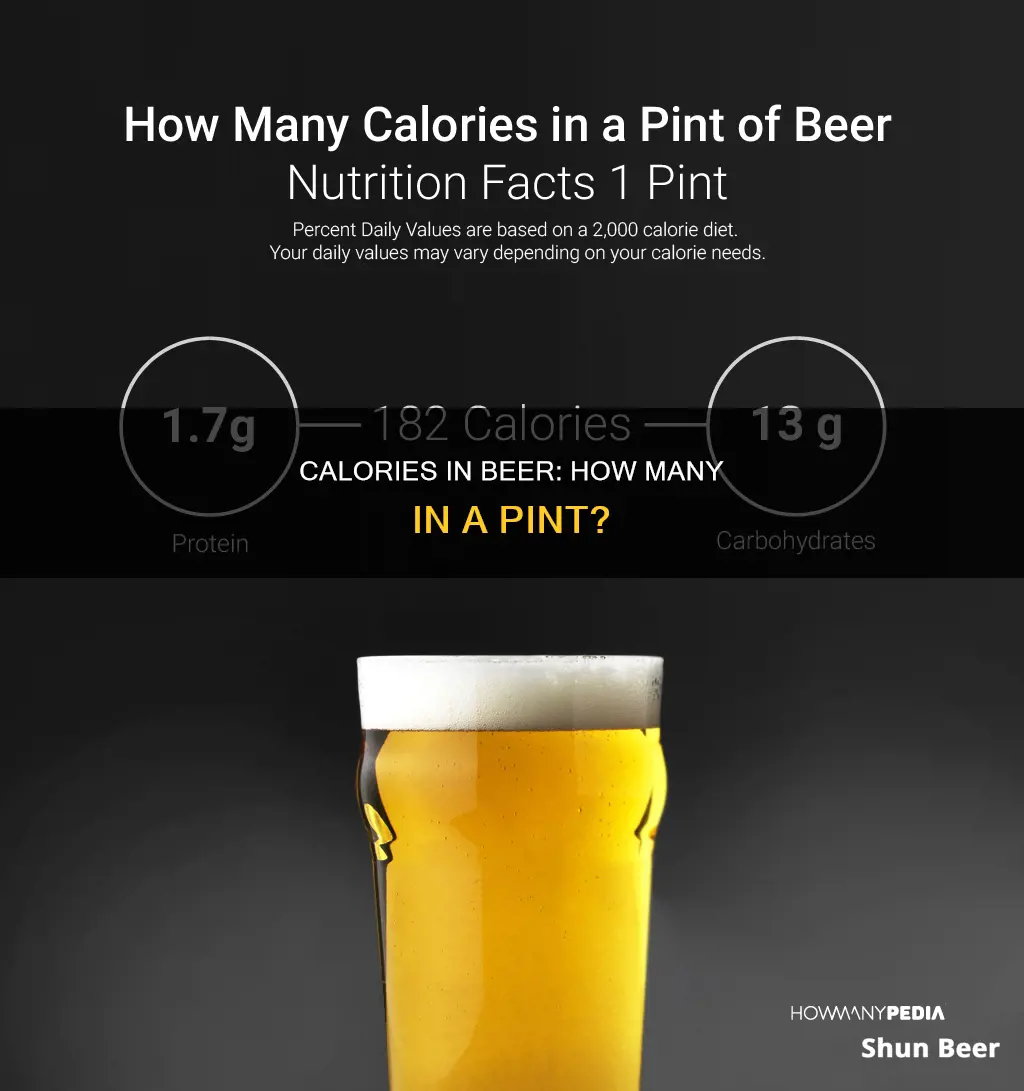
Beer is a popular drink worldwide, but it's also high in calories. A standard pint of beer contains around 215 calories on average, but this can vary depending on the brand and style. For instance, a pint of 4% ABV lager typically has about 180 calories, while stronger lagers can contain up to 222 calories. The calories in beer come mainly from alcohol and carbohydrates, with alcohol contributing about 60% of the total. Beer is made by fermenting cereals, most commonly malted barley, which produces alcohol. Alcohol is highly calorific, with seven calories per gram—nearly as much as pure fat. The remaining calories come from residual carbohydrates that weren't fully fermented during brewing.
Characteristics of a Standard Pint of Beer
| Characteristics | Values |
|---|---|
| Calories | 180-257 calories, with an average of 215 calories |
| Calories by Source | 60% from alcohol, 40% from carbohydrates |
| ABV | 4% - 5% |
| Calories per Gram of Alcohol | 7 calories |
| Calories per Gram of Carbohydrates | 4 calories |
What You'll Learn

Calories in beer come from alcohol and carbohydrates
The number of calories in beer is influenced by its alcohol content and carbohydrates. Alcohol is highly calorific, with a gram of alcohol containing seven calories, almost as much as a gram of pure fat. Beer is made by fermenting cereals, most commonly malted barley, which produces alcohol. The rest of the calories in beer come from residual carbohydrates that weren't fully fermented during the brewing process.
Different types of beer contain varying quantities of carbohydrates. For example, lagers tend to contain fewer carbs than ales, which in turn have fewer carbs than stouts. However, the number of calories in beer is largely dependent on its alcohol content. A pint of 4% ABV beer contains 129 calories from alcohol alone.
On average, a typical pint of beer contains around 215 calories. The exact amount varies across brands and styles, but it generally ranges from 188 to 257 calories per pint. If you're watching your weight or your calorie intake, it's important to consider the number of calories in beer and how they can add up, especially when consumed in larger quantities or over multiple days.
Beer is typically made from grains such as malted barley, which are broken down into sugar during the brewing process. These sugars contribute to the total amount of carbohydrates in the beverage. Brewers might also add honey or fruit puree, which contain additional carbohydrates.
While beer does contain a relatively high number of calories, it's not inherently fattening. The occasional pint of beer won't make you gain weight. However, regularly consuming more calories than you need can lead to weight gain. For example, drinking three pints of standard-strength beer in one evening can easily add up to 600 calories.
If you're mindful of your calorie intake, there are a few strategies you can employ. Opting for lower-alcohol beers or non-alcoholic beers can help reduce your calorie intake. Additionally, drinking in moderation, spacing out your drinks, and choosing lower-calorie alternatives can also make a difference.
Blonde Beer Calorie Count: Low-Carb, Low-Guilt Pleasure
You may want to see also

Beer with higher alcohol content will have more calories
Beer is made by fermenting cereals, most often malted barley, which produces alcohol. Alcohol is highly calorific, with a gram of alcohol containing seven calories, almost as much as a gram of pure fat. The rest of the calories in beer come from residual carbohydrates that weren't fully fermented during the brewing process.
Different types of beer contain varying quantities of carbohydrates. For example, lagers tend to contain fewer carbs than ales, which, in turn, have fewer carbs than stouts. However, this is not always the case, as some lagers may contain as many calories as a dark beer.
The calorie content of beer depends on several factors, including serving size, type of beer, and alcohol content. Beer with higher alcohol content will have more calories. For example, a typical 12-ounce can of light beer with 4% alcohol contains about 100 calories, while an IPA with 7-10% alcohol can have 200-300 calories. Similarly, a 5% alcohol beer like Budweiser has around 150 calories, while a strong lager with 4.5% ABV typically has 200-235 calories in a pint.
Craft, seasonal, and high-alcohol beers tend to have more calories than lighter ones. If you're watching your calorie intake, opting for low-alcohol or alcohol-free beers can be a good choice, as these usually contain fewer calories.
Calorie Counting: Sopora Beer's Nutritional Breakdown
You may want to see also

Lagers tend to have fewer carbs than ales
A standard pint of beer contains on average 180 calories, which is about the same as a slice of pizza. The calories in beer come from the alcohol and the carbohydrates it contains. About 60% of the calories in beer come from alcohol, and 40% from carbohydrates. Beer is considered to have empty calories as it does not provide a significant amount of nutrients.
Some popular lagers include Skinny Lager, Budweiser, and Heineken. Skinny Lager is a low-calorie option, with 35% fewer calories than other premium lagers on the market and only 3g of carbs per 330ml. Budweiser Select has only 55 calories and 2.4% alcohol, while Heineken Silver Lager has a light mouthfeel and flavour profile with virtually no bitterness.
When it comes to ales, there are also low-calorie options available. For example, the Lagunitas DayTime IPA slashes calories and carbs without sacrificing flavour. Dogfish Head Slightly Mighty Lo-Cal IPA offers a hop-forward flavour with less than 4g of total carbohydrates. Allagash's Saison ale is another flavourful option, packed with citrus notes and peppery accents.
Stout Beer Calories: How Many in a Regular Serving?
You may want to see also

Drinking beer can delay the body's fat-burning process
A standard pint of beer typically contains around 150 to 180 calories, depending on the type of beer and its alcohol by volume (ABV) percentage. For example, a pint of 4% ABV lager contains around 180 calories, while a typical beer with no specified ABV is said to contain 150 calories.
Drinking beer can indeed delay the body's fat-burning process. When consumed, alcohol is seen as a toxin by the body, which then focuses its efforts on processing and eliminating it. As a result, other bodily functions, including fat burning, are temporarily halted. This delay can last up to 36 hours, according to some sources.
The body's preference for metabolizing alcohol over fat is due to the higher number of calories in alcohol. Beer, being calorie-dense, is an attractive energy source for the body. The liver, which is responsible for metabolizing alcohol, will prioritize breaking down the alcohol calories before turning to burn fat.
Additionally, alcohol interferes with the body's blood sugar regulation, causing a condition called reactive hypoglycemia, which further increases appetite and cravings, especially for foods that quickly raise blood sugar levels, such as low-fiber starches and salty foods. This can lead to overeating and excess calorie consumption, resulting in fat build-up when combined with the delayed fat-burning process.
It is worth noting that moderate alcohol consumption, defined as no more than two drinks per day for men and one drink per day for women, does not necessarily lead to weight gain. However, heavy drinking can contribute to weight gain and hinder weight loss efforts. Therefore, it is important to drink in moderation and be mindful of the potential impact on the body's fat-burning processes and overall health.
Calorie Count in Sapporo Premium Beer Revealed
You may want to see also

Beer is not fattening in moderation
The number of calories in a pint of beer varies depending on the type of beer and its alcohol content. On average, a typical pint of beer contains around 215 calories, but this can range from 188 to 257 calories per pint. A pint of 4% ABV lager, for example, contains around 180 calories, which is similar to the number of calories in a slice of pizza.
Beer calories come from two main sources: alcohol and carbohydrates. About 60% of beer calories come from alcohol, which has seven calories per gram, almost as much as a gram of pure fat. The remaining calories come from residual carbs that weren't fully fermented during the brewing process. Different types of beer contain varying amounts of carbs, with lagers generally containing fewer carbs than ales, and ales containing fewer carbs than stouts.
If you're mindful of your weight or want to lead a healthier lifestyle, there are several strategies you can employ to cut down on beer calories. Firstly, opt for lower-alcohol beers. Beers with lower ABV will have fewer calories, allowing you to enjoy a few drinks without worrying about the impact on your weight. Secondly, avoid drinking in rounds. When drinking with friends, it's easy to lose track of your consumption and end up with more calories than you intended. Instead, buy your drinks at your own pace or alternate between alcoholic and non-alcoholic beverages. Finally, you can simply drink less regularly.
In conclusion, beer consumed in moderation will not lead to weight gain. By understanding the calorie content of different beers and practising mindful drinking habits, you can enjoy the occasional pint without compromising your health or fitness goals.
Calorie Count of Red Trolley Beer: Know Before You Drink
You may want to see also
Frequently asked questions
On average, a typical pint of beer contains around 215 calories. The exact amount varies across brands and styles, but across the 10 most popular beers in the UK, it ranges from 188 to 257 calories per pint.
No, the prevailing opinion is that the darker the beer and the denser the head, the more carbs and calories it contains. However, this is not always the case. For instance, some lager beers can contain more calories than darker beers.
You can use the following formula: Calories in an alcoholic drink = (ABV% x 2.5) x fl oz. You will need to know the percentage of alcohol in the beer (ABV or alcohol by volume) and the volume you're drinking in fluid ounces (fl oz).







